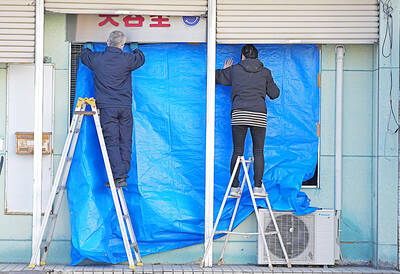Tokyo-based Taiwanese writer Liu Li-erh (劉黎兒) yesterday in Taipei shared her latest fact-finding from Japan to say that now is the best time to put a halt to nuclear power in Taiwan.
Having lived in Tokyo for 30 years and experienced the devastating earthquake and tsunami that struck Japan on March 11 last year and led to the nuclear disaster at the Fukushima Dai-ichi nuclear plant, Liu said that more than 1 million Japanese continue to live in areas with high daily radiation exposure and the total cost of damage from the nuclear disaster is still too high to estimate.
“If nuclear power is not abolished, then our assets — especially those fixed assets in Taipei City and New Taipei City (新北市) — would be ‘abolished’ if a nuclear disaster occurs,” Liu told participants at a two-day forum on transforming Taiwan into a sustainable low-carbon environment.
Liu said that although her house is located about 80km away from the Fukushima Dai-ichi plant, the property has lost almost all of its value due to the high levels of radiation present since the disaster.
She said that the Japanese government had set provisional regulations for radiation-contaminated food at 500 Bq/kg for radioactive cesium levels immediately after the disaster, and reduced the limit to 100 Bq/kg in April. However, this is still 1,000 times the limit for rice (0.1 Bq/kg) in force prior to the disaster.
The Fukushima Dai-ichi catastrophe proved that sometimes even the government is unable to cope with the enormous damage from a nuclear meltdown, she said.
Many Japanese have learned from the disaster that “the knowledge of nuclear specialists is limited, they are not experts on evaluating the harm and impact that nuclear disasters can cause humans or society,” she said, adding: “So it becomes important to make judgements on our own, instead of always believing the government.”
Many experts from Japan and other countries are now very concerned about the more than 1,500 fuel rods housed in the storage pool inside the damaged No. 4 reactor building at Fukushima Dai-ichi, warning that a disaster worse than the three reactor meltdowns could happen if the pool collapses, she added.
“If the storage pool breaks and runs dry, the nuclear fuel inside will overheat and explode, causing a massive radiation release over a wide area,” she said.
Japan’s Mainichi Shimbun on April 2 said that “if this were to happen, residents in the Tokyo metropolitan area would be forced to evacuate.”
“Maybe some international experts have not noticed that we have about 8,000 spent fuel rods stored in the cooling pool at the Guosheng Nuclear Power Plant [in Wanli District (萬里), New Taipei City] and a total of about 16,000 throughout the country,” she said.
Taiwan has good reason to abandon all nuclear power operations because many international experts have already warned that the two nuclear power plants in northern Taiwan pose an immediate threat to greater Taipei, she said, adding that in February France’s Le Monde newspaper warned about the risk from poor management of spent fuel rods at the Guosheng plant.
Taiwan has a high reserve electricity capacity, so there would be no power shortage even if the nuclear power plants were immediately closed down, Liu said.
Many Japanese companies and government offices have saved up to 50 percent on their electricity consumption since the disaster, “so Taiwan can surely do the same to end our reliance on nuclear power,” she added.

Taiwanese were praised for their composure after a video filmed by Taiwanese tourists capturing the moment a magnitude 7.5 earthquake struck Japan’s Aomori Prefecture went viral on social media. The video shows a hotel room shaking violently amid Monday’s quake, with objects falling to the ground. Two Taiwanese began filming with their mobile phones, while two others held the sides of a TV to prevent it from falling. When the shaking stopped, the pair calmly took down the TV and laid it flat on a tatami mat, the video shows. The video also captured the group talking about the safety of their companions bathing

US climber Alex Honnold is to attempt to scale Taipei 101 without a rope and harness in a live Netflix special on Jan. 24, the streaming platform announced on Wednesday. Accounting for the time difference, the two-hour broadcast of Honnold’s climb, called Skyscraper Live, is to air on Jan. 23 in the US, Netflix said in a statement. Honnold, 40, was the first person ever to free solo climb the 900m El Capitan rock formation in Yosemite National Park — a feat that was recorded and later made into the 2018 documentary film Free Solo. Netflix previewed Skyscraper Live in October, after videos

Starting on Jan. 1, YouBike riders must have insurance to use the service, and a six-month trial of NT$5 coupons under certain conditions would be implemented to balance bike shortages, a joint statement from transportation departments across Taipei, New Taipei City and Taoyuan announced yesterday. The rental bike system operator said that coupons would be offered to riders to rent bikes from full stations, for riders who take out an electric-assisted bike from a full station, and for riders who return a bike to an empty station. All riders with YouBike accounts are automatically eligible for the program, and each membership account

A classified Pentagon-produced, multiyear assessment — the Overmatch brief — highlighted unreported Chinese capabilities to destroy US military assets and identified US supply chain choke points, painting a disturbing picture of waning US military might, a New York Times editorial published on Monday said. US Secretary of Defense Pete Hegseth’s comments in November last year that “we lose every time” in Pentagon-conducted war games pitting the US against China further highlighted the uncertainty about the US’ capability to intervene in the event of a Chinese invasion of Taiwan. “It shows the Pentagon’s overreliance on expensive, vulnerable weapons as adversaries field cheap, technologically